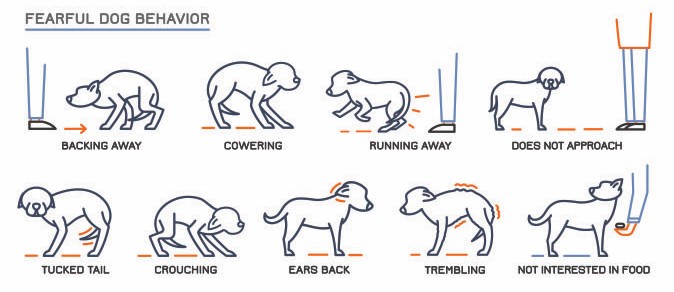Fidos Facing Fear
We know how much you love your dog and want to help them! It can be so difficult to see your dog’s fearful dog behavior or anxious dog behavior. We can help.
For some, it can be confusing when your dog is happy and relaxed in some situations but then fearful in others. There are things you can do to help your dog feel safe. You and your dog can take steps toward finding relief from your dog’s fear or your dog’s anxiety.
We know how much you love your dog and want to help them! It can be so difficult to see your dog’s fearful dog behavior or anxious dog behavior. We can help.

Dog Body Language of a Fido Facing Fear
A dog facing fear or anxiety dog may display fearful or anxious body language signals. Their body language helps us to understand how they are feeling. If your dog is displaying any of the following body language signals, you may have a dog facing fear or anxiety.

What a dog facing fear look like
A dog facing fear or anxiety may:
- have their dog ears pinned back,
- hide in their crate or may not come out from under the bed or behind the sofa or toilet,
- give a warning bark,
- hide,
- cower,
- show the whites of their eyes giving a “whale eye,”
- bare their teeth,
- tremble,
- run away,
- back away or does not approach, and
- not be interested in food.
Do we need to know where YOUR dog’s fear comes from in order to help them?
While it may seem important to know where YOUR DOG’s fear comes from, in many instances, we may never know for certain. It is okay to not know where your dog’s fear comes from. The most important questions is: how do you help your fido facing fear begin to feel safe again? We can help you in this journey with your dog.

The Progeny of Fear
There are many things that happen early on in life that can contribute to fear. Fear can start to build even before a puppy is born. It’s so important to know where fear comes from, in general, so we can take steps to prevent it.

Fear is acquired prior to your dog turning 8 weeks old, because…
- dog mom’s behavior when puppies are very young,
- stress during pregnancy, which can lead to stress hormones transferring to puppies in utero, and
- genetics, through poor breeding practices.

Fear is built and sustained in your dog over time, because of…
Go at your Dog’s Pace so that They can Overcome their Fears
Our certified Dog Trainers work with you and your dog using modern dog training approaches. We work toward modifying the underlying emotional response to a trigger, so that your dog does not feel fearful.
Our dog training approach gives our clients scientifically sound training methods. We train with rewards, and you start by taking the time to understand and meet our dog’s needs. Then, we modify underlying emotional response to triggers, using the scientific principles of animal learning.
If training is not effective enough alone, then we encourage our clients to seek veterinary help with behavior modification medications. We have excellent relationships with the local veterinary behaviorists.

Are you ready to get started?
For Fidos Facing Fear, we recommend starting with a 2-lesson package. Schedule your lessons 2 weeks apart. From there, you and your trainer can decide which dog training protocols are working best for you and your dog.
Empathy and Expertise: Addressing Fearful Dog Behavior
Understanding and modifying fearful behavior in dogs requires patience, empathy, and specialized knowledge. At Calvert Dog Training, we specialize in helping fidos facing fear overcome their anxieties through gentle and effective behavior modification techniques. Our 30-minute online consultations provide a safe space for you to discuss your dog’s fears and receive expert guidance on how to address them. For a special introductory rate, these sessions allow our trainers to tailor strategies specifically for your dog’s needs. Let us help you build confidence and trust in your fido facing fear, paving the way for a happier, more relaxed life together.

